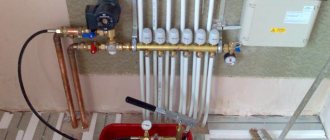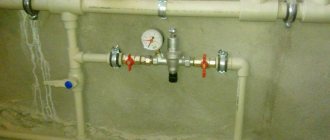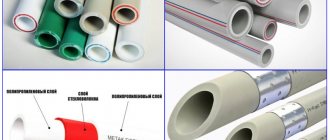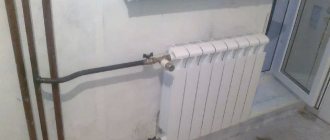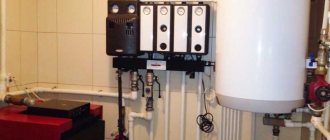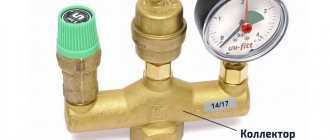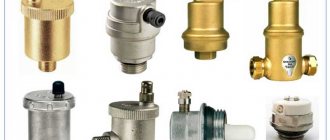Here you will learn:
- Optimal indicator
- Peak values
- Pressure drop in the heating circuit
- Increase in pressure in the heating circuit
Closed heating systems are becoming more and more common. The process of their installation is fine-tuned to the smallest detail. Nevertheless, users still have questions about their operation. A typical example of this is the pressure indicator in the heating circuit. In this review, we will tell you what pressure should be in a closed-type heating system and how to deal with its surges and drops.
What is the pressure in the heating system - let's start with the basics
The owner of a private house or apartment with an autonomous heating system needs to know several basic concepts:
- Pressure is indicated in atmospheres, bars or megapascals.
- There is static pressure in the network, which is created by water or other coolant. This type of pressure exists even when the boiler is not working.
- The force moving water along the heating circuit creates dynamic pressure. It, in turn, affects all elements of the network from the inside.
- There is a concept of maximum permissible pressure. If the pressure rises too much, an emergency situation may occur.
- The most vulnerable link during pressure surges will be the radiator inside the boiler. Depending on the model, it can withstand approximately three atmospheres. Pipes and batteries are less fragile and can handle much higher rates. However, a lot also depends on the material from which they are made. Therefore, find out in advance which heating batteries are right for you.
So what exactly is considered work pressure? Another important fact to understand. This indicator is directly affected by the length of the pipeline, the number of storeys of the building, and the number of radiators in the system. Therefore, its value must be calculated at the project stage, taking into account all the features of equipment and materials.
For two- or three-story houses, the optimal indicator is 1.5-2 atmospheres. For housing with more floors, a working pressure of 2-4 atmospheres is permissible, and it is advisable to install additional pressure gauges on the floors to monitor the indicators.
Kinds
There are several types of pressure:
- static (a parameter depending on the height of the liquid column at rest, its pressure on the elements of the heating structure; when calculating, it must be taken into account that 10 m gives a result of 1 atmosphere);
- dynamic (created by circulation pumps, but depends not only on their characteristics, occurs due to the movement of the energy carrier inside the pipeline, affects structural elements from the inside);
- working (composed of quantities of the first and second types, this is the level of normal and trouble-free operation of all structural elements).
Open and closed heating systems - what are the features
Autonomous heating systems that are used in private homes are of two types:
- open, when through the expansion tank it communicates with the atmosphere, and the water circulates due to natural convection: heating, rising, cooling, falling,
- closed, when the system is isolated from the atmosphere, and the water inside it is pushed by a special pump.
For an open system to work properly, the boiler is installed at the lowest possible point, and the expansion tank at the top. The diameter of the pipes at the outlet of the boiler is wider, at the entrance it is narrower. This system is suitable for small, one-story houses.
The second option is more often used. The pressure in closed systems in small houses should also remain within 1.5-2 atmospheres; this is enough if the circuit is not too long and is not equipped with a huge number of radiators. If there are high floors or a large number of rooms in the house, it is possible to install an additional pump.
Please note that when initially filling the system with cold coolant, air may enter. After its removal, the initial pressure will drop, this is natural. Therefore, it needs to be raised again by adding water, but not brought a little to the working mark. After heating, following the laws of physics, the pressure will increase.
The pump is the main advantage of this system. Its power allows you to make the pipeline as long as you like, and the number of radiators as you require. Moreover, they can be connected both in series and in parallel. The second option is preferable because it creates less load on the boiler.
A closed system is also convenient for the off-season, because the presence of a pump allows you to set the heating to minimum levels.
Why raise the pressure?
The pressure in the supply line is higher than in the return line. This difference characterizes the heating efficiency as follows:
- A small difference between the supply and return makes it clear that the coolant successfully overcomes all resistance and transfers the calculated amount of energy to the premises.
- An increased pressure drop indicates increased section resistance, decreased flow velocity and excessive cooling. That is, there is insufficient water flow and heat transfer to the rooms.
For reference. According to the standards, the optimal pressure difference in the supply and return pipelines should be in the range of 0.05–0.1 Bar, maximum 0.2 Bar. If the readings of 2 pressure gauges installed on the line differ more, then the system is not designed correctly or needs repair (flushing).
To avoid high drops on long heat supply branches with a large number of batteries equipped with thermostatic valves, an automatic flow regulator is installed at the beginning of the line, as shown in the diagram.
So, excess pressure in a closed heating network is created for the following reasons:
- to ensure forced movement of the coolant at the required speed and flow rate;
- to monitor the condition of the system using a pressure gauge and recharge or repair it in time;
- Coolant under pressure heats up faster, and in the event of emergency overheating, it boils at a higher temperature.
We are interested in the second item on the list - the pressure gauge readings as a characteristic of the serviceability and performance of the heating system. They are of interest to homeowners and apartment owners who independently maintain home communications and equipment.
The pressure in the heating system of a private home must be regularly monitored
Now that you know what pressure should be in the heating system, you need to learn how to check it. Any modern boiler is most often equipped with a pressure gauge with an arrow that shows the pressure level in the system. Such devices are more convenient than electronic ones because they do not require additional power.
However, one measurement point is not enough. Additional pressure gauges, in accordance with technical regulations, should be placed at the inlet and outlet of the boiler, at the highest and lowest segments of the system, before and after the pump. Additional pressure gauges in places where pipes branch will also come in handy. Together they will allow you to analyze and better control the situation. But the measuring instruments themselves only state a fact, but do not in any way affect what is happening in the circuit. They also need to be checked from time to time for serviceability and accuracy.
How to prevent air from entering the circuit
First of all, you need proper installation of the heating system. Each user should be able to quickly and easily eliminate air jams that occur. To do this you need:
- Constantly check the tightness of the pipe connections in the system.
- Before starting the heating, air is pumped into the pipeline, the pressure of which is 20% greater than the working one. Pressure gauge readings are taken at the beginning of the process and after 20 minutes after injection. If the values have not changed over this period, then the system can be considered sealed. A leak is indicated by a drop in the instrument needle or a characteristic whistle on a damaged section of the pipeline.
- Filling the circuit must be done by smoothly pumping cold water. The air accumulated in the system is released several times using Mayevsky taps.
- Experts recommend using stainless radiators.
- It is not advisable to frequently replace the coolant, because fresh, clean water always contains a small percentage of oxygen.
To bleed air, install air vents in problem areas. If you were unable to achieve the optimal result, leave a request on the website or call +7.
The pressure in the heating system is increasing - how to find out the reason
By checking the pressure gauges from time to time, you may notice that the pressure inside the system is increasing. This can happen for several reasons:
- you increased the temperature of the coolant and it expanded,
- the coolant movement has stopped for some reason,
- a gate valve (valve) is closed in some part of the circuit,
- mechanical blockage of the system or air lock,
- additional water constantly enters the boiler due to a loosely closed tap,
- during installation, the requirements for pipe diameters were not met (larger at the outlet and smaller at the inlet to the heat exchanger),
- Excessive power or flaws in the pump. Its failure is fraught with destructive water hammer for the circuit.
Accordingly, it is necessary to find out which of the listed reasons led to a violation of the working norm and eliminate it. But it happens that the system worked successfully for months and suddenly there was a sharp jump, and the pressure gauge needle went into the red, emergency zone. This situation can be caused by boiling of the coolant in the boiler tank, so you need to reduce the fuel supply as quickly as possible.
Modern individual heating devices are equipped with a mandatory expansion tank. It is a sealed block of two compartments with a rubber partition inside. The heated coolant enters one chamber, while air remains in the second. In cases where the water overheats and the pressure begins to rise, the partition of the expansion tank moves, increasing the volume of the water chamber, and compensates for the difference.
In case of boiling or a critical surge, the boiler is equipped with mandatory safety relief valves. They can be located in the expansion tank or in the pipeline immediately at the outlet of the boiler. In an emergency, part of the coolant from the system pours out through this valve, saving the circuit from destruction.
Well-designed systems also have bypass valves, which, in the event of a blockage or other mechanical blockage of the main circuit, open and release coolant into the small circuit. This safety system protects equipment from overheating and damage.
Do I need to explain how important it is to monitor the serviceability of these system elements? If the volume is small or the pressure inside the expansion tank is low, as well as coolant leaks through microcracks, even significant pressure drops in the system are possible.
Repairing the leak
After identifying the location of the leak, the necessary repairs are carried out, which includes the following actions:
- cutting out and replacing the damaged section of the pipeline;
- securing weak connections;
- wrapping with sealing tape;
- replacement of faulty system components with working elements.
Repairs to broken pipes should be carried out by a qualified plumber. If the pressure loss is not determined, then you should check whether the boiler equipment is working properly.
Hard water is the enemy of the system
The condition of the inner surface of all elements of the heating circuit is affected by the quality of the water used as a coolant. If it is hard, rich in salts and minerals, then when heated it will form scale and sediment, which over time will damage the equipment and cause blockages in the system. And those, in turn, will affect the pressure in pipes and radiators.
As a preventative measure, it is better to fill the circuit with specially prepared, demineralized water. If this is not possible, the boiler must be cleaned regularly. It is better to entrust this work to an experienced professional who is well acquainted with the construction of expensive equipment. He will disconnect the heat exchanger and wash it with special reagents.
In the case of large amounts of deposits, the entire system can be subjected to a similar treatment. But only real professionals in their field can cope with this task.
Possible faults and corrective actions
Significant pressure drops in the heating system when the boiler operating temperature changes can be caused by incorrect calculation of the volume of the expansion tank and the pressure in its air chamber.
Leaks are usually found at threaded connections and are due to insufficient sealant. It will be easier for a beginner to achieve the tightness of such a connection using the Tang it Unilock sealing thread. In case of some “overdose”, unlike tow, it does not cause destruction of the screwed-on part.
In polypropylene pipelines, leaks often occur due to improper welding technology.
For example, some users weld pipes without a coupling - just butt welding.
Such a connection is very short-lived and breaks down very quickly under pressure.
Incorrectly made or defective connections must be cut off and replaced with high-quality ones.
If the water used as a coolant has not been desalted, the heat exchanger will have to be descaled over time. To do this, the boiler is disconnected from the heating circuit and washed with special reagents, for example, Antiscale. The entire heating system can be subjected to such flushing, but due to its complexity, this task should be entrusted to professionals.
Spring safety valves can stick, so they must be opened periodically using a special lever.
In the USSR, the issue of reducing the cost of construction, including the organization of the heating system, was especially relevant. It was at that time that the Leningradka heating system for private and apartment buildings was invented. Let's consider whether it is relevant today.
In what cases is a hydraulic arrow needed for heating and how it functions, read this article.
We are losing it, or why the pressure drops
There can be two main reasons for a gradual or sudden decrease in pressure in an autonomous system:
- heat exchanger malfunction,
- one or more leaks in the circuit.
Any damage to the boiler must be diagnosed and promptly repaired. Causes of pressure loss may include contamination, microcracks, high wear, manufacturer defects and, again, defects in the expansion tank. Any damage is corrected accordingly.
Leaks are often the cause of pressure drops. There are many weak points - these are poor-quality soldering of plastic or metal pipes of the circuit, and loose connections with radiators, and breaks in worn pipes, and cracks in the rubber membrane of the expansion tank when the coolant enters and remains in the air chamber.
In the latter case, you can detect the leak yourself: just press the spool, with the help of which air is pumped into the chamber. Water dripping or flowing from inside will confirm your guess.
Finding a leak in a pipeline, which is often hidden inside the floor or walls, is quite difficult. First, you should inspect the visible areas. Pay attention to the floor, even if it is dry, spots of dried water may remain in places of leakage. Salt or rust deposits at the joints may also indicate a loss of tightness.
If the design of the circuit allows, you can turn off individual sections of the network one by one, so it will be easier to find the breakdown.
In cases where the pipeline is hidden or visual inspection is unsuccessful, pressure testing will be required. It is quite difficult to do it yourself, since it requires both skill and special equipment. First, the coolant is drained from the system, the boiler and radiators are insulated, and air is forced into the circuit with a compressor under pressure. The end result is that the network pressure should be 20 percent higher than the operating norm. The system is left in this state for several hours and the pressure is measured again. If it falls, you need to look for places where there is depressurization. To do this, visible seams can be lubricated with soapy water; the escaping air will appear as bubbles. It will tell you where the leaks are and the characteristic hissing sound.
The breakdown areas are further sealed or the failed section is replaced with a new one.
Leak test
To ensure that the heating is reliable, after installation it is checked for leaks (pressure tested).
This can be done immediately on the entire structure or its individual elements. If a partial pressure test is carried out, then after its completion the entire system must be checked for leaks. Regardless of which heating system is installed (open or closed), the sequence of work will be almost the same.
Preparation
A test pressure is considered to be 1.5 times the working pressure. But this is not enough to completely detect a coolant leak. Pipes and couplings can withstand up to 25 atmospheres, so it is better to check the heating system under this pressure.
The corresponding indicators are created using a hand pump. There should be no air in the pipes: even a small amount of it will distort the tightness of the pipeline.
The highest pressure will be in the lowest place of the system; a monometer is installed there (reading accuracy 0.01 MPa).
Stage 1 - cold test
Over the course of half an hour, the pressure in the water-filled system is increased to the initial values. Do this twice, every 10-15 minutes. The fall will continue for another half hour, but without exceeding 0.06 MPa, and after two hours - 0.02 MPa.
At the end of the inspection, the pipeline is inspected for leaks.
Stage 2 - hot check
The first stage has been successfully completed, you can begin hot leak testing. To do this, connect a heating device, most often a boiler. Maximum performance indicators are established; they should not be greater than the calculated values.
Houses are preheated for at least 72 hours. The test is passed if no water leakage is detected.
Plastic pipeline
The plastic heating system is checked at the same temperature of the coolant in the pipeline and the environment. Changing these values will increase the pressure, but in fact there is a water leak in the system. For half an hour the pressure is maintained at a value one and a half times higher than the standard value. If necessary, pump it up slightly.
After 30 minutes, the pressure is sharply reduced to a reading equal to half the working one, and held for an hour and a half. If the indicators begin to increase, it means that the pipes are expanding and the structure is sealed.
Often, when checking a system, technicians perform a pressure drop several times, either increasing or decreasing it, so that it resembles normal, everyday working conditions. This method will help identify leaky connections.
Air test
Multi-storey buildings undergo airtightness testing in the fall. Instead of liquid in such cases, air can be used. The test results are slightly inaccurate due to the fact that the air is first heated during compression, then cooled, which contributes to a drop in pressure. Compressors will help increase this parameter.
The sequence for checking the heating system is as follows:
- The structure is filled with air (test values - 1.5 atmospheres).
- If a hiss is heard, it means there are defects, the pressure is reduced to atmospheric pressure and the defects are eliminated (for this, a foaming substance is used, it is applied to the joints).
- The pipeline is again filled with air (pressure - 1 atmosphere), held for 5 minutes.
If the pressure drop does not exceed 0.1 atmosphere, then the heating system is completely sealed.
Jumps in a working heating system and how to deal with them
If, even a few weeks after the start of the regular heating season, the pressure in the system “dances”, it is worth rechecking all problem areas and making sure that each of the elements of the heat exchanger safe operation unit is working:
- pressure gauge,
- an air vent through which air leaves the coolant,
- a safety valve that releases part of the water in the event of a pressure surge or boiling (by the way, it is better to connect the valve to the sewer, otherwise hot water will end up on the floor),
- For large houses, expensive but very “smart” automatic machines are relevant, capable of monitoring the situation around the clock.
In any case, it is worth remembering that problems with the heating system are not only a loss of a comfortable microclimate in the home and material costs, but also a threat to the safety of both the entire building and its inhabitants. This means that inattention is unacceptable here.
Application of aluminum batteries
Installation of aluminum radiators
When water comes into contact with aluminum, a thin film forms on the surface of the metal. This produces hydrogen as a by-product, which can be compressed. And due to this, the pressure decreases. But this phenomenon does not happen all the time, but only in new radiators. Over time it stops and the problem resolves itself.
Along with a decrease in pressure in the pipeline of your own or multi-story building, its increase may also occur.
The reasons for the increase in pressure in the boiler can be different:
- Broken boiler feed tap. The rubber seal in it may sag or simply become rough. Once a defect is identified, the gaskets must be replaced.
- The heat exchanger is leaking. To check, you need to dismantle the boiler and test it with air. If a breakdown is detected, the part must be replaced with a new one.
When repairing the boiler, you need to unplug it and turn off the cold water.



